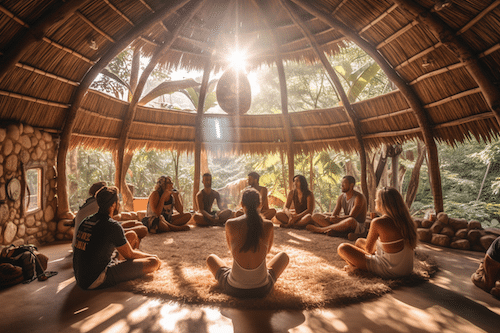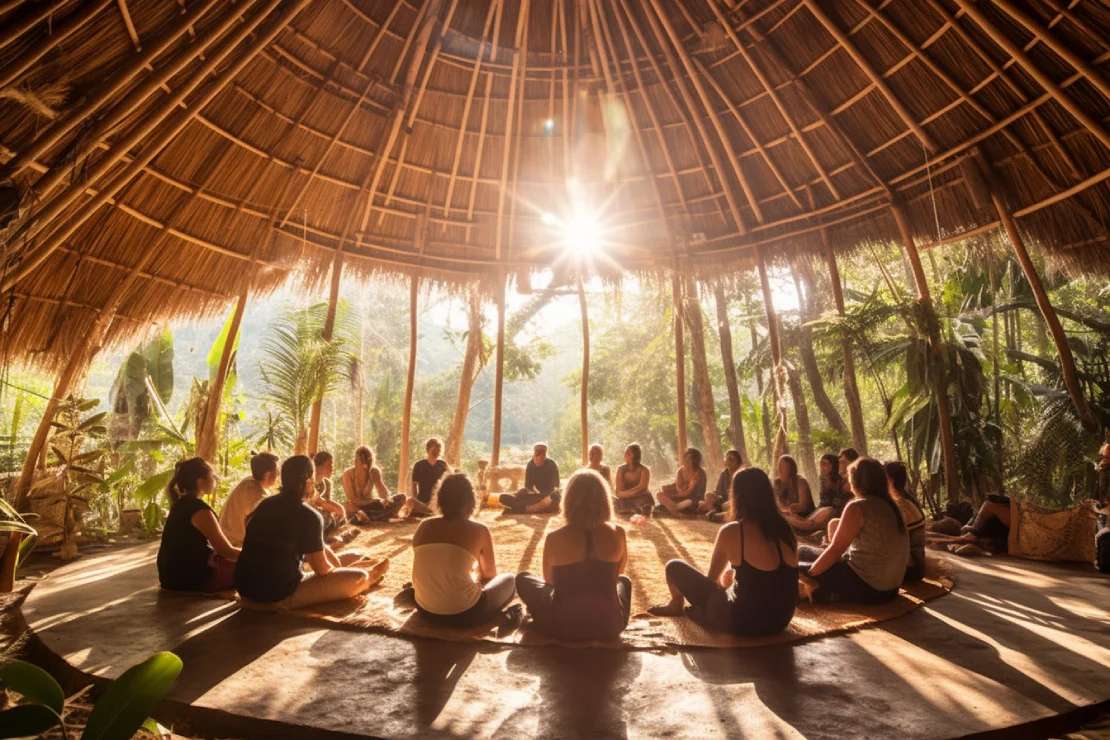What to Expect during a Psilocybin Mushroom Retreat

Every psilocybin mushroom retreat has its own unique structures and offerings, but most of them share common elements:
1. Serene Atmospheres
Retreat centers are usually located in peaceful natural environments, away from distractions and the fast-paced nature of daily life. These settings provide an ideal atmosphere for introspection, self-reflection, and connection with nature.
Retreat centers often incorporate the following:
- Less technology: Retreat centers typically provide WiFi, unless they are completely off the grid. However, most do not offer televisions or in-room phones. Air conditioning may not be guaranteed, although some facilities are starting to offer this amenity.
- Reduced indulgences: Guests will likely not find coffee, alcohol, sweets, or processed foods at mushroom retreat centers. Meat may also be excluded from the menu for the duration of the retreat. However, guests are not deprived as they are provided with chef-cooked meals made from fresh, local ingredients.
- Isolation: While some retreat centers may offer excursions outside the property, most psychedelic retreats operate as if the outside world does not exist. Guests are often required to stay on-site for various reasons, including safety and maximizing the introspective process.
2. Group Activities and Discussions
Retreats typically involve group activities such as meditations, yoga sessions, nature walks, and communal meals. These activities foster a sense of community and provide opportunities for guests to share their experiences, insights, and challenges, to the extent they are comfortable doing so. Group activities can also help participants prepare for the high-dose mushroom experience.
- Breathwork ceremonies: These ceremonies, such as holotropic breathing, can induce an altered state of consciousness similar to psychedelic journeys. Through rhythmic breathing patterns, participants can experience expanded states of awareness, heightened sensory perceptions, and emotional release.
- Movement practices: Activities like yoga and stretching bring the group together to release stagnant energy and collectively relax the body, ultimately opening the mind.
- Intention-setting ceremonies: These ceremonies, usually held on the first day, involve symbolic objects, guided meditations, prayers, and sharing sessions that foster a sense of togetherness and collective intention, which can enhance the psychedelic journey.
3. Medical Intake
Medical intake is a crucial component of any mushroom retreat. It is essential for safety. Reputable facilities should have licensed medical providers who screen guests for potential health issues prior to the psilocybin sessions.
Intake appointments are usually straightforward. They typically last 15 to 30 minutes and involve taking the guest’s blood pressure, asking about medications and medical history, and assessing any potential psychological barriers. Well-equipped facilities, such as Sayulita Wellness Retreat, also provide experienced medical staff to monitor guests throughout the retreat.
4. Psilocybin Mushroom Ceremonies
Guided psilocybin sessions are the central element of a mushroom retreat experience. These sessions are carefully facilitated by experienced indigenous shamans, trained guides, or traditional healers who create a supportive space for participants to surrender to the medicine.
The dosage, duration, and structure of the sessions may vary depending on the retreat, type of mushroom used, and the specific day. Most high-dose journeys last between five to seven hours and typically occur in the evening.
Regardless, all reputable facilities will design psilocybin ceremonies to minimize the risk of “bad trips” and maximize the potential benefits.
First ceremony
Many retreat centers start with a small psilocybin microdose (around 0.15 – 0.3 grams) or a moderate dose (1-1.5 grams) to ease guests into working with the compound.
- Microdoses typically provide sub-threshold amounts that enhance mood and self-awareness without causing significant psychoactive effects.
- Moderate doses alter the mind without completely dissolving the ego, allowing individuals to explore their inner worlds while maintaining a comfortable level of control.
Lighter ceremonies usually occur during the day and last a few hours.
Second ceremony
The second journey is typically the highest dose and often takes place at night. Most retreat centers organize group ceremonies in a shared space, such as a temple, illuminated by candles and filled with music and natural sounds.
Guests often lie on mattresses arranged around a sacred altar, equipped with eye masks, tissues, and buckets in case of purging. Temples should also provide accessible bathrooms and ample water for guests.
Other centers, like Sayulita Wellness, offer private psilocybin therapy ceremonies between the guest and their psychotherapist for more personalized care. These one-on-one sessions take place in the guest’s private room or suite.
Prior to the session, guests typically consult with facilitators and medical staff to determine the appropriate dosage. Throughout the journey, guides may offer booster doses to individuals who want to delve deeper into the experience.
Facilitators usually recommend that guests stay lying down with their eye masks on to enhance the inner work. However, those who need to use the facilities or simply want to look around are free to do so.
Third ceremony
Many retreat centers offer a third dose of psilocybin to help guests solidify the lessons learned from the previous sessions. The dosage for the third journey can vary, ranging from micro to macro, depending on the individual’s needs.
Beyond psilocybin
Some retreat centers may offer other psychoactive compounds in addition to psychedelic mushrooms to enhance purification, celebrate cultural traditions, and promote focus and healing. For example, trained psychotherapists at Sayulita Wellness provide guests with the option to experience smokeable DMT towards the end of their high-dose psychedelic therapy session. According to Andrew, a psychotherapist at Sayulita Wellness:
“DMT can really help people have a breakthrough, especially those who may have had an experience that left them with more questions than answers. It provides that final closure or wisdom nugget that can help people move forward. Because it is common to resist the experience and feel stuck, DMT pushes people across the finish line and, in my opinion, makes integration more effective.”
Guests may also have access to other medicines such as:
5. Integration and Aftercare
Following the psilocybin journeys, participants can expect to engage in psychedelic integration sessions and aftercare practices that extend for weeks after the retreat ends.
Integration involves reflecting on the insights gained during the psychedelic experiences and incorporating those discoveries into everyday life. Approaches to integration may include journaling, therapy or counseling, and adopting new habits that support personal growth and well-being. Andrew, from Sayulita Wellness, shares:
“Our psychotherapists work one-on-one with guests during the retreat to create action plans for continued growth. We also schedule 4 weeks of follow-up calls after guests return home to ensure that the transformations made at the retreat are solidified. We believe that successful integration relies on accountability.”
FAQs
-
What are the benefits of a mushroom retreat experience?
-
What activities can I expect during a mushroom retreat?
-
How are the psilocybin ceremonies conducted?
-
What is psychedelic integration?
-
How long does the integration process last?
A mushroom retreat offers various benefits, including introspection, self-reflection, connection with nature, community-building, enhanced mood and self-awareness, exploration of inner worlds, personal growth, and healing.
During a mushroom retreat, you can expect activities such as meditations, yoga sessions, nature walks, communal meals, breathwork ceremonies, movement practices like yoga and stretching, intention-setting ceremonies, and group discussions.
The psilocybin ceremonies are carefully facilitated by experienced indigenous shamans, trained guides, or traditional healers. The dosage, duration, and structure of the ceremonies may vary, but they are designed to create a safe and supportive space for participants to explore the psychedelic experience.
Psychedelic integration involves reflecting on the insights and experiences gained during the psychedelic journeys and incorporating them into everyday life. It may include journaling, therapy or counseling, and adopting new habits that support personal growth and well-being.
The integration process can extend for weeks after the retreat ends. Many facilities offer follow-up calls or sessions with psychotherapists to ensure the transformation and commitments made during the retreat are solidified.


